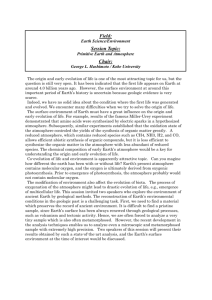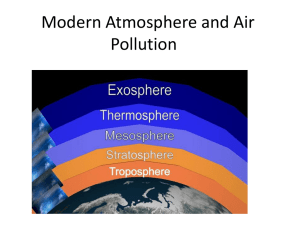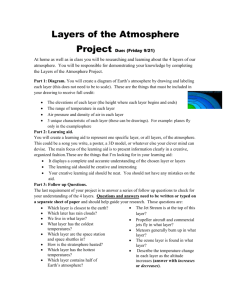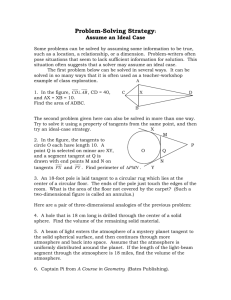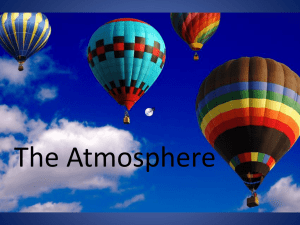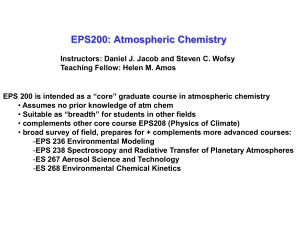1. What is atmospheric stability?
advertisement
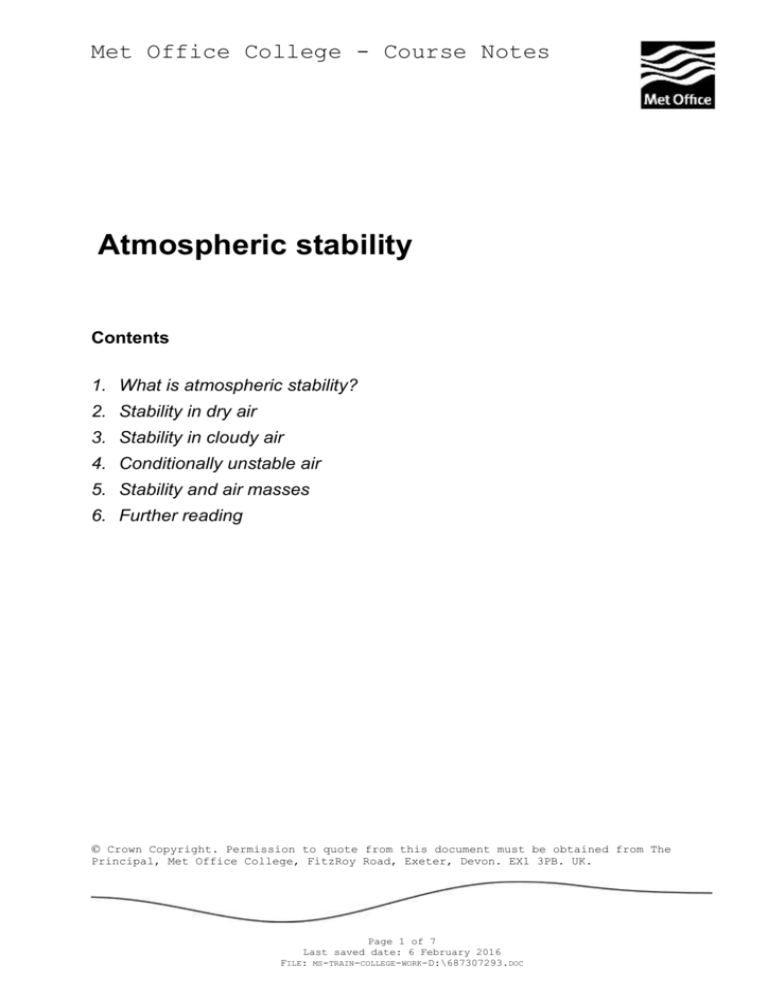
Met Office College - Course Notes Atmospheric stability Contents 1. What is atmospheric stability? 2. Stability in dry air 3. Stability in cloudy air 4. Conditionally unstable air 5. Stability and air masses 6. Further reading Crown Copyright. Permission to quote from this document must be obtained from The Principal, Met Office College, FitzRoy Road, Exeter, Devon. EX1 3PB. UK. Page 1 of 7 Last saved date: 6 February 2016 FILE: MS-TRAIN-COLLEGE-WORK-D:\687307293.DOC Met Office College 1. What is atmospheric stability? On some days the weather is characterised by vigorous vertical motions, producing deep cumulus or cumulonimbus clouds, heavy showers and thunderstorms. At other times the sky is overcast with a continuous layer of grey, featureless stratus cloud. Why does the atmosphere exhibit such marked variations in cloud formation from day to day? The nature of vertical motions in the atmosphere depends on two factors: the vertical temperature profile; the availability of moisture to form clouds. Most of us are familiar with the idea that warm, less dense air will rise, while cool, heavy air will sink. From this idea it follows that if the air aloft is very cold, warmer air near the earth's surface will tend to rise. Indeed, it will continue to rise until it reaches a level where it is no longer warmer than the surrounding atmosphere. This type of atmosphere is termed unstable (see box, below). If there is sufficient moisture for clouds to form, an unstable atmosphere is characterised by convective clouds – cumulus and cumulonimbus. If, however, the air aloft is warmer than the air below, any cold air at the surface that is pushed upwards will find itself colder than its surroundings, and will sink back to the surface. Hence, vertical motions are inhibited, and clouds tend to form in broad, flat layers. This type of atmosphere is termed stable (see box, below). If there is sufficient moisture for clouds to form, a stable atmosphere is characterised by stratiform clouds such as stratus, altostratus and nimbostratus. For a fuller explanation of atmospheric stability, there is one additional factor to be taken into account: as air moves up or down in the atmosphere its temperature does not remain constant. Stable, unstable and neutral equilibrium A body is said to be in stable equilibrium if, when given a small disturbing impulse, it then returns to its original position. A body is said to be in unstable equilibrium if, when given a small disturbing impulse, it continues to move in the direction of the impulse. A body is said be in neutral equilibrium if, when given a small disturbing impulse, it then remains in the disturbed position. Page 2 of 7 Last Saved Date: 6 February 2016 File: ms-train-college-work-d:\687307293.doc Atmospheric Stability 2. Stability in dry air As air rises in the atmosphere, it experiences a steady decrease in pressure. This causes its temperature to fall at a constant rate of 3°C for every 1000 ft of ascent. This rate of cooling is known as the dry adiabatic lapse rate1 (DALR). It is constant throughout the atmosphere, as long as the air remains cloud-free (or unsaturated). Now, consider the temperature change experienced by a ‘bubble’ of air rising from the earth’s surface. If its initial temperature is 10°C, by the time it reaches a height of 3000 ft it will have cooled to 1°C. At this height, the temperature of the surrounding air will depend on the general lapse rate in that location (called the environmental lapse rate, or ELR). Three cases can be considered: 1. The environmental lapse rate is less than the DALR. If the ELR is 2°C per 1000 ft, the temperature 3000 ft above the surface will be 4°C. However, the bubble of air at this level has cooled to 1°C. Since it is cooler than its surroundings it will tend to sink. This case is, therefore, a stable atmosphere. Height (ft) Actual temperature of the atmosphere 3000 Temperature of dry air rising from the surface and cooling at 3°C per 1000 ft 2000 1000 –2 +1 +4 +7 +10 Temperature (°C) Figure 1. Temperature profiles in a dry, stable atmosphere. 2. The environmental lapse rate is equal to the DALR. If the ELR is 3°C per 1000 ft, the temperature 3000 ft above the surface will be 1°C. The bubble of air at this level also has a temperature of 1°C. Since it has the same temperature as its surroundings there will be no forcing on it, either up or down. This case is described as a neutral atmosphere. 1. The term lapse rate is used to describe the rate of temperature fall with height in the atmosphere. Hence a positive lapse rate indicates a decrease of temperature with increasing height. Page 3 of 7 Last Saved Date: 6 February 2016 File: ms-train-college-work-d:\687307293.doc Met Office College Height (ft) Actual temperature of the atmosphere 3000 Temperature of dry air rising from the surface and cooling at 3°C per 1000 ft 2000 1000 –2 +1 +4 +7 +10 Temperature (°C) Figure 2. Temperature profiles in a dry, neutral atmosphere. 3. The environmental lapse rate is greater than the DALR. If the ELR is 4°C per 1000 ft, the temperature 3000 ft above the surface will be –2°C. However, the bubble of air at this level has only cooled to 1°C. Since it is warmer than its surroundings it will continue rising. This case is, therefore, an unstable atmosphere. Height (ft) Actual temperature of the atmosphere 3000 Temperature of dry air rising from the surface and cooling at 3°C per 1000 ft 2000 1000 –2 +1 +4 +7 +10 Temperature (°C) Figure 3. Temperature profiles in a dry, unstable atmosphere. These three stability states in dry air can be summarised as follows: ELR < DALR : stable atmosphere ELR = DALR : neutral atmosphere ELR > DALR : unstable atmosphere 3. Stability in cloudy air The three cases above describe vertical motions in the atmosphere in the absence of cloud. When air rises within cloudy air, the cooling causes water vapour to condense onto the cloud droplets. This condensation process gives out heat, changing the adiabatic lapse rate. Thus a ‘bubble’ of air rising within a cloud in the lowest few thousand feet of the atmosphere cools at only around 1.5°C. This is known as the saturated adiabatic lapse rate (SALR). It is not constant, but increases with height in the atmosphere. Page 4 of 7 Last Saved Date: 6 February 2016 File: ms-train-college-work-d:\687307293.doc Atmospheric Stability In considering the stability of cloudy air, the atmospheric temperature profile should be compared to the SALR. Consider the temperature change experienced by a 'bubble' of air rising from the earth's surface through cloud. If its initial temperature is 10°C, by the time it reaches a height of 3000 ft it will have cooled to approximately 5.5°C. At this height, the temperature of the surrounding air will depend on environmental lapse rate. Again, three cases can be considered: 1. The environmental lapse rate is less than the SALR. If the ELR is 1°C per 1000 ft, the temperature 3000 ft above the surface will be 7°C. However, the bubble of cloudy air at this level has cooled to 5.5°C. Since it is cooler than its surroundings it will tend to sink. This is a stable atmosphere. Height (ft) Actual temperature of the atmosphere 3000 Temperature of cloudy air rising from the surface and cooling at ~1.5°C per 1000 ft 2000 1000 –2 +1 +4 +7 +10 Temperature (°C) Figure 4. Temperature profiles in a cloudy, stable atmosphere. 2. The environmental lapse rate is equal to the SALR. If the ELR is 1.5°C per 1000 ft, the temperature 3000 ft above the surface will be 5.5°C. The bubble of cloudy air at this level also has a temperature of 5.5°C. Since it has the same temperature as its surroundings there will be no forcing on it, either up or down. This is a neutral atmosphere. Height (ft) Actual temperature of the atmosphere 3000 Temperature of cloudy air rising from the surface and cooling at ~1.5°C per 1000 ft 2000 1000 –2 +1 +4 +7 +10 Temperature (°C) Figure 5. Temperature profiles in a cloudy, neutral atmosphere. Page 5 of 7 Last Saved Date: 6 February 2016 File: ms-train-college-work-d:\687307293.doc Met Office College 3. The environmental lapse rate is greater than the SALR. If the ELR is 2°C per 1000 ft, the temperature 3000 ft above the surface will be 4°C. However, the bubble of cloudy air at this level has only cooled to 5.5°C. Since it is warmer than its surroundings it will continue rising. This is an unstable atmosphere. Height (ft) Actual temperature of the atmosphere 3000 Temperature of cloudy air rising from the surface and cooling at ~1.5°C per 1000 ft 2000 1000 –2 +1 +4 +7 +10 Temperature (°C) Figure 6. Temperature profiles in a cloudy, unstable atmosphere. These three stability states in dry air can be summarised as follows: ELR < SALR : stable atmosphere ELR = SALR : neutral atmosphere ELR > SALR : unstable atmosphere 4. Conditionally unstable air From sections 2 and 3 it can be seen that the effects of vertical motion depend upon whether the air is dry or cloudy. For example, consider again a ‘bubble’ of air at the surface with a temperature of 10°C, and an environmental lapse rate of 2°C per 1000 ft (see Section 2, case 1 and Section 3, case 3): The environmental lapse rate is less than the DALR and greater than the SALR. With an ELR of 2°C per 1000 ft, the temperature 3000 ft above the surface will be 4°C. If the bubble remains dry and rises to this height, it will cool to 1°C. Since it is cooler than its surroundings it will sink back to the surface (i.e. stable). However, if the bubble is cloudy, it will only cool to 5.5°C. Since this is warmer than its surroundings it will continue rising (i.e. unstable). This case, where the stability depends upon whether the air is dry or cloudy, is called conditionally unstable air. Page 6 of 7 Last Saved Date: 6 February 2016 File: ms-train-college-work-d:\687307293.doc Atmospheric Stability Height (ft) Actual temperature of the atmosphere 3000 Temperature of cloudy air rising from the surface and cooling at ~1.5°C per 1000 ft 2000 Temperature of dry air rising from the surface and cooling at 3°C per 1000 ft 1000 –2 +1 +4 +7 +10 Temperature (°C) Figure 7. Temperature profiles in a conditionally unstable atmosphere. 5. Stability and air masses Polar maritime and arctic maritime air masses travel from their cold source regions towards Western Europe over a comparatively warm sea surface. Such air masses tend to be conditionally unstable, with strong vertical motions associated with cumulus or cumulonimbus clouds. Tropical maritime air travels from the sub-tropical Atlantic over a comparatively cold sea surface towards Western Europe. This air is stable in both the dry and cloudy cases (termed absolutely stable) and is characterised by layer clouds (stratus or stratocumulus). Stable, tropical maritime air is also associated with deep layer clouds (alto-stratus, nimbo-stratus and cirro-stratus) when subject to mass ascent within depressions and frontal zones. Polar continental and tropical continental air masses may be absolutely stable or conditionally unstable, depending on the time of year and the surface temperature en route from their source region. It is unusual for the atmosphere to be unstable for both the dry and cloudy cases. This absolutely unstable condition arises near the surface under strong sunshine, but only extends to significant heights in the atmosphere over hot desert regions. 6. Further reading Further information on atmospheric stability may be found in the following publications, both of which are available in the Met. Office College library. HMSO (1994) Handbook of Aviation Meteorology, pp. 35–36. Barry, R.G. and Chorley, R.J. (1992) Atmosphere, Weather and Climate, pp. 66–69. Page 7 of 7 Last Saved Date: 6 February 2016 File: ms-train-college-work-d:\687307293.doc
